Grave Risk
Nadine Squire
 |
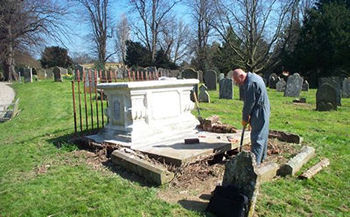 |
 |
| Railed chest tomb at St Dunstan’s church, Cranbrook. From top to bottom: before repairs, duing repairs and after repairs |
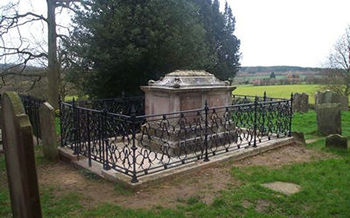 |
| The ornate gated tomb of the family of Jane Austen showing the family monogram in the railings at St Margaret’s church, Horsmonden. |
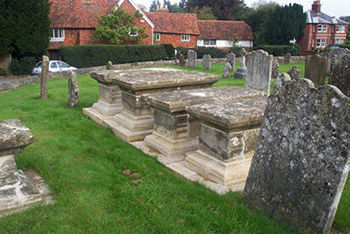 |
| A row of four chest tombs at St Mary’s church, Goudhurst which have been raised out of the ground. The clean area around the bases shows how far submerged they were. |
In 1996 Tunbridge Wells Borough Council identified the need for a more structured approach to listed buildings at risk and work started on a survey of all the borough’s 3,000 listed buildings. The buildings were assessed using English Heritage criteria and as a result, 36 buildings capable of occupation and 89 buildings not capable of occupation (70 of which were gravestones) were identified as ‘at risk’.
In December 1998 councillors approved the implementation of a five-year project with three main aims. One of the aims was to target gravestones and monuments through a new project.
It is diffcult to gain permission to repair graves at risk as the people responsible for them are often hard to contact. Unfortunately, sometimes all family members are dead or have moved away and as a result the numbers at risk are high.
Named the ‘Grave Risk Project’, Tunbridge Wells Borough Council officers started by contacting the Diocese of Rochester and Canterbury. After discussions a procedure was agreed that the council would work directly with local churches.
By law, to carry out any work on a grave an effort has to be made to contact the owners. The council advertised its statutory notices in the London Gazette (a publication that contains all public notices). Signs called ‘citations’ were erected, usually inside the churches, advising the proposals for work and encouraging anyone with an interest to come forward. Owners were required to reply to the adverts within 28 days.
Sadly, only one owner was tracked down, so the council worked directly with the churches to repair all the graves. Tunbridge Wells Borough Council agreed to fund 90 per cent of repair costs with the church councils donating the remaining costs. As the borough council provided most of the funding, officers were responsible for implementing the work.
In total, the council dealt with 14 churches around the borough. The project included gravestones, chest tombs (many railed), sundials, war memorials, mounting blocks and wooden ‘bedstead’ memorials. Common repairs included:
- dismantling and re-erection of stones and tombs to correct levels and lines
- removal of destructive and invasive plants such as holly, ivy, sycamore, and grasses and mosses
- re-fixing broken stones with epoxy-based mortars and stainless steel pins
- re-placing rusting dog-cramps with new stainless steel ones
- re-pointing with lime putty or hydraulic lime-based mortars
- ‘weathering’ some joints to allow water run-off
- re-levelling surrounding site area and minisoakaways to ensure good drainage
- re-bedding, re-fixing and re-painting of railings.
Tunbridge Wells Borough Council spent a total of £530,000 on the overall Buildings at Risk project. The total expenditure by the council on the Grave Risk Project was £110,000 with the additional total outlay of £11,000 by the various churches.
The council intends to continue to review its register of buildings at risk on a five-yearly basis. Grants for repairs to gravestones and tombs will be reviewed at the same time, but it is considered that the recent repair project will have postponed the need for major repairs by 25 years. One clear conclusion from the project is that to wait for owners to repair listed stones is not a practical option. If councils are serious about tackling problems caused by years of neglect, they must consider taking on the responsibility and working in partnership with churches.
Senior Design and Heritage Officer, Brian Hayward, believes that Tunbridge Wells is one of the first local authorities in the UK to have restored all of their graves that were identifed as ‘at risk’ in this way. The most important factor in getting the work done was a good partnership between the council, church and diocese.
The project was welcomed by the Diocese of Canterbury. As Ian Dodd said: 'Appropriate conservation of memorials in Church of England churchyards is a major concern in many of our small communities and the financial assistance offered by the council has been of great support and encouragement. We would certainly recommend that other local authorities consider adopting a similar scheme'.
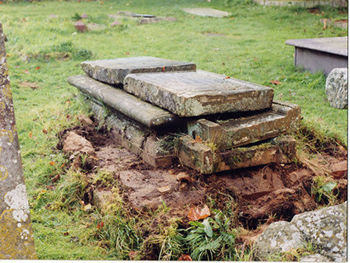 |
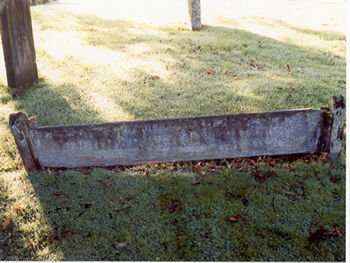 |
| Some chest tombs such as this one one at St Mary the Virgin, Speldhurst were in such a poor state that they had simply been dismantled. | An unusual wooden ‘bedstead’ memorial before repairs at St Margaret’s Church, Horsmonden. |



